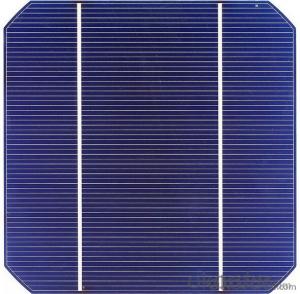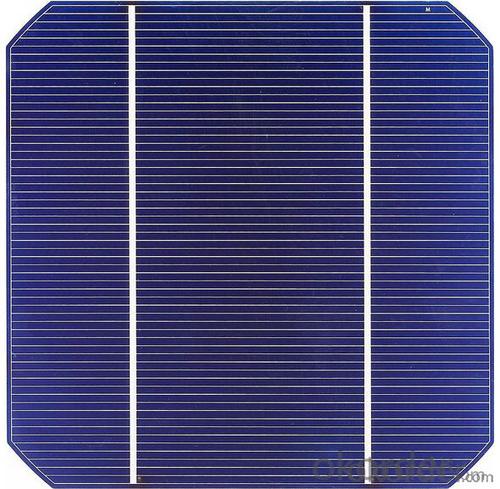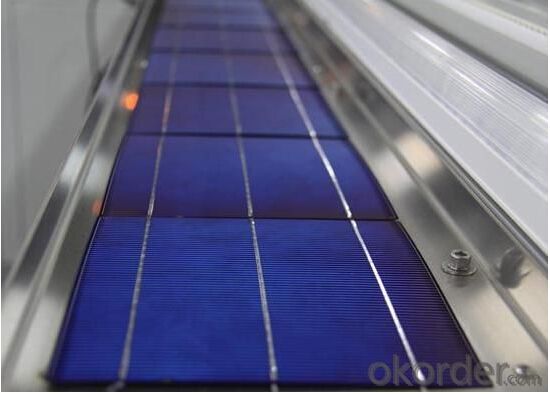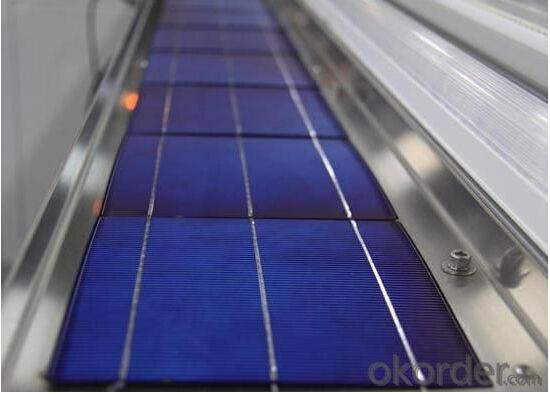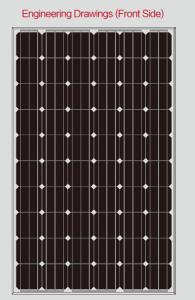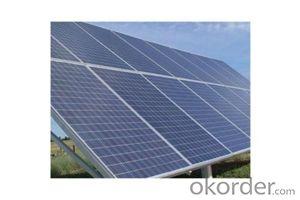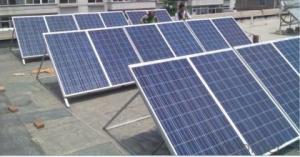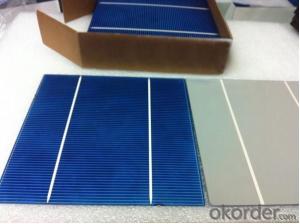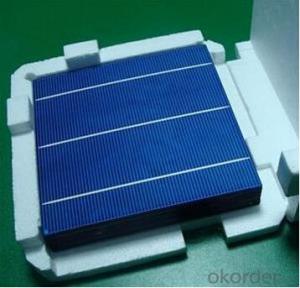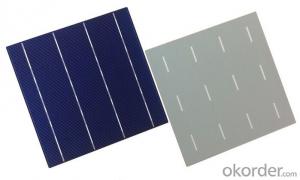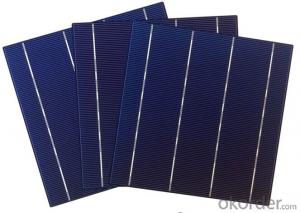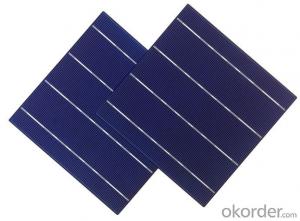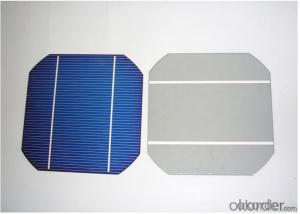Solar Panels Melbourne Victoria - A Grade and B Grade 3BB and 4BB High Efficiency Solar Cells 18.1%
- Loading Port:
- Shanghai
- Payment Terms:
- TT OR LC
- Min Order Qty:
- 10000 watt
- Supply Capability:
- 100000000 watt/month
OKorder Service Pledge
OKorder Financial Service
You Might Also Like
Specification
1.Product Description:
Specifications of Poly Solar Cells
Dimension | 156mm X 156 mm ±0.5mm |
Wafer Thickness | 200um ±30um |
Front(-) | Four 1.1mm wide bus bars(silver) with distance 39mm, Acid texturized surface with blue silicon nitride AR coating. |
Back(+) | 2.4mm wide silver/aluminum soldering pads, aluminum back surface field. |
Temperature Coefficient of Poly Cells
Voc.Temp .coef.%/K | -0.351%/K |
Isc.Temp .coef.%/K | +0.035%/K |
Pm.Temp. coef.%/K | -0.47%/K |
Electrical Characteristic of Poly Cells
Efficiency code | 1720 | 1740 | 1760 | 1780 | 1820 | 1840 | |
Efficiency (min) | (%) | 17.2 | 17.4 | 17.6 | 17.8 | 18.2 | 18.4 |
Pmax | (W) | 4.186 | 4.234 | 4.283 | 4.332 | 4.429 | 4.478 |
Voc | (V) | 0.631 | 0.632 | 0.634 | 0.636 | 0.640 | 0.642 |
Isc | (A) | 8.446 | 8.485 | 8.523 | 8.573 | 8.660 | 8.700 |
Vmp | (V) | 0.525 | 0.527 | 0.529 | 0.531 | 0.535 | 0.537 |
Imp | (A) | 7.973 | 8.035 | 8.097 | 8.160 | 8.280 | 8.340 |
2.Advantages of Poly Solar Cells
1). Tire-1 Solar Cells’ Manufacturer Quality Guarantee. With a complete and sophisticated quality government system, our Quality Management have arrived world’s leading place. Customer can receive Tire-1 Cells Maker’s Quality Standard Products.
2). Trusted Warranty. We can supply trusted after-sales service to our customer. If our cells are found not in conformity to the specification of manufacturer, or should the inspected quantity found in shortage, or should the packing found damaged, the buyer has the right to claim to the seller. The claim, if any, should be presented to seller within 30 days after cargo's arrival date to the port, together with related inspection report and photos issued and provided by a reputable independent surveyor such as SGS.
3). World’s Leading Manufacturer Equipment. We imported the newest and leading production equipment from abroad. Advanced equipment can guarantee the stable quality of cells. Auto production line can also save labor cost which will further cut our production cost.
4). Bulk supply: With the production capacity of 500MW, we can produce large quantity every month. This can satisfy most customer requirement.
3.Usage and Applications of Poly Cells
Solar cells are often electrically connected and encapsulated as a module.
Photovoltaic modules often have a sheet of glass on the front (sun up) side, allowing light to pass while protecting the semiconductor wafers from abrasion and impact due to wind-driven debris, rain, hail, etc. Solar cells are also usually connected in series in modules, creating an additive voltage.
Connecting cells in parallel will yield a higher current;our solar cells have passed IEC Certification.
With high quality and stable quality. Our Cells can greatly improve the performance of Solar Modules.
4.Pictures of Product
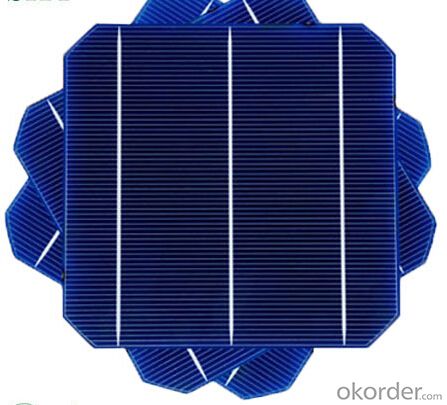
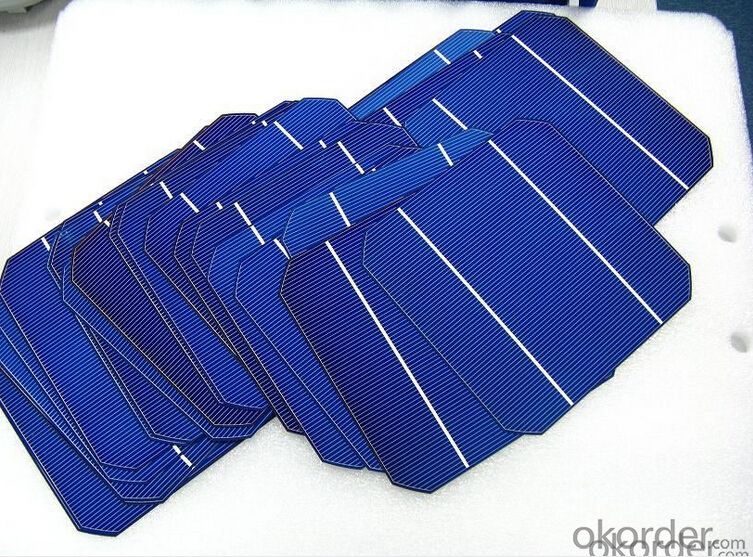
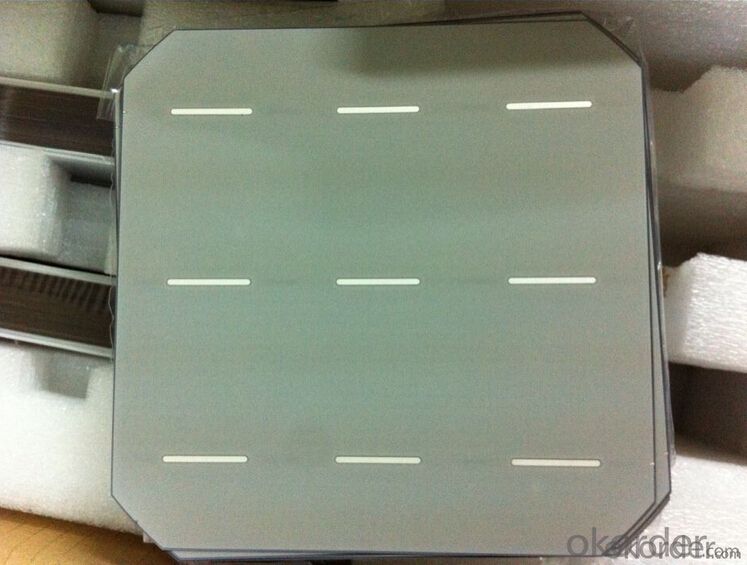
5.Packaging & Delivery of Poly Cells
Carton Box Package and Deliver by air. It should be noticed that it should be avoid water, sunshine and moist.
We have organized several common questions for our clients,may help you sincerely:
6.FAQ
1. What’s price per watt?
A: It’s depends on the quantity, delivery date and payment terms of the order. We can talk further about the detail price issue. Our products is high quality with lower price level.
2. Can you tell me the parameter of your solar cells?
We have different series of cells with different power output, both from c-si to a-si. Please take our specification sheet for your reference.
3. How do you pack your products?
We have rich experience on how to pack the panels to make sure the safety on shipment when it arrives at the destination.
4. Can you do OEM for us?
Yes, we can.
5. How long can we receive the product after purchase?
In the purchase of product within three working days, We will arrange the factory delivery as soon as possible. The perfect time of receiving is related to the state and position of customers. Commonly 7 to 10 working days can be served.
- Q: Hello, I have been trying to go green, I Have purchase somesolar panel they are about 45watts I been putting it against my window and getting ok power out of it enough for my lights and a couple of low watts gadget (cellphone, 2v light, portable dvd) for couple of hours.But its seem to drain the 2v faster then I can charge Am I getting the most power out of my panel?Or should I place it on the roof? I'm in Texas and it gets hot and sunny the sun beam my room windows pretty good during 4pm-6pm.
- It will generate MUCH more current if placed outside of the window. The best position is pointing directly south. Over the period of one day, you will get the most average sunlight pointing in that direction.
- Q: If my school uses 88240kWh of electricity per month and I have 000 50W solar panels running for 6 hours a day, does it mean it will take 88240kWh / {{[(50W x 3600s)*000]/000}kWh x 6} number of hours to generate that much electricity (88240kWh)?
- running six hours a day doesn't mean much. You need to look at the solar insulation charts for your school's geographical location to come up with a better factor. The easiest number for you to use is sun hours. For example, Washington DC averages 4.23 hours. Do a Yahoo search for sun hours and you should find lots of charts. Solar panels rated at 50W give this output at full sun near noon at full brightness (no clouds). The sun hour factor makes it easy to find the equivalent number of full brightness hours. So, using Washington DC as an example you have: 000 panels * 50W * 4.23 sunhours/day = 634kWh a day on average. You state your school uses 88240kWh/month which is 6274kWh a day. This would mean you need ten times more solar panels since there is no way to get more daylight. Be careful to put in all the units in your formula and cancel them out to make sure you don't end up with a nonsense result. The title of the question would be answered as followed: 50W/000 * 4.23 sunhours/day = 0.63kWh/day or 9kWh per month or 228kWh a year. These are annual averages. If you wanted a specific month, you would need the sun hours for that month. Hope this helps.
- Q: Im doing a project and i have to persuade some one that solar pannels are great... help ?
- nan
- Q: Can solar panels be installed on forests or protected areas?
- Yes, solar panels can be installed on forests or protected areas, but it requires careful planning and consideration to minimize the impact on the environment and wildlife. The installation should be done in a way that avoids clearing large areas of trees and minimizes disturbance to the local ecosystem. By adopting best practices and consulting with experts, solar panels can be installed on forests or protected areas in a sustainable and responsible manner.
- Q: Most solar panels (the flat ones that go onto roofs of houses) reject electricity produced by the panels if they are too low in voltage. For example, on a cloudy day, although the panels may still get some sunlight to produce some electricity, it is rejected because its too low in voltage. So, does anyone have any ideas?
- What about a battery bank as a sink? By that, I mean the batteries absorb the low/high voltage, and if the solar panels do cut out, then the batteries pick up the load and keep the inverter going. Just a thought.
- Q: I am starting to think about solar panels as an option for my home. I have done some research on panels, to be honest its all very confusing. There are many different panels some with 60 watts some all the way up to 20 watts. My household currently uses about 2700 to 3400 kWh every two months. So based off of my power usage maybe you can answer some of the following questions:What kind of panels should I be looking at?Which panel manufacturers give the best bang for the buck (reliable/affordable)?Anything else I should be concerned about?I am just starting out in educating myself on solar power so please excuse me if I sound very naive. Any information that you may have will be helpful. Thanks in advance.
- Unfortunately, I can't give you a lot of specifics on what you should use. However, I can tell you that the very best system for you simply might not be available to you, in which case it really doesn't matter how good it is. Your best bet would be to talk to a supplier in your area and see what is available, THEN start looking at the differences between those. Unfortunately, solar panels aren't quite to the point of being a common-place product...yet. Another thing to consider would be how old your roof is. You might want to look into the possibility of building-integrated materials if you are in need of a new roof. Talking with somebody who sells the panels in your area will help you understand a lot more than just doing raw research. Get their take on it, then fact check and research what they tell you so you know you're not getting ripped off.
- Q: Can solar panels be used for irrigation systems?
- Yes, solar panels can be used for irrigation systems. Solar energy can power the pumps and other electrical components required for irrigation, reducing the reliance on fossil fuels and making the system more sustainable and cost-effective.
- Q: Can solar panels be installed on a high-rise building?
- Yes, solar panels can be installed on a high-rise building. In fact, high-rise buildings are ideal candidates for solar panel installations due to their large surface areas and access to sunlight. However, certain factors such as structural considerations, building ownership, and local regulations need to be taken into account before installation.
- Q: my dad wants to run all his lights in his shop on solar panels, he has 9 600 watt hps lights. how many solar panels would it take to pull this off
- If he lives in a sunny area, he should contact a local solar installer about getting a grid-tied solar system to offset his electric bill. It's not necessary to supply all the electricity from solar. The system will work seamlessly right alongside grid electricity, and your father can choose whether to supply 20% of the electricity or 99% by sizing the system appropriately.
- Q: if you know the area of the panel can u calculate for the wattage or voltage of the panel..
- You need to know how many solar cells are in the panel and what is the rated current each cell will produce. This information should be listed on the panel. Each cell will produce from 0.5 to 0.55 volts DC per cell and each cell will produce a current that is dependent on the size of the cell and the type of material the cell is made from. If the cells are connected in series then the voltage of each cell will add together, that is if you have 30 cells connected in series they should generate about 5 to 6.5 volts DC. If each cell generates .2 amps, then you multiply the voltage of 5 volts DC times .2 amps DC equals 8 watts of power. The current of each cell does not add together when you connect the cells in series only the voltage of each cell. If you connect the 30 cells in parallel then the current of each cell adds together but the voltage of each cell does not. That is 0.5 Volts DC times 36 amps equals 8 watts. The power (watts) produced will be the same. See our blog on the products page to see how to connect solar cells in series and in parallel. We also have a PDF file of solar cells and their rated output current sorted by watts per area and their manufacturer.
Send your message to us
Solar Panels Melbourne Victoria - A Grade and B Grade 3BB and 4BB High Efficiency Solar Cells 18.1%
- Loading Port:
- Shanghai
- Payment Terms:
- TT OR LC
- Min Order Qty:
- 10000 watt
- Supply Capability:
- 100000000 watt/month
OKorder Service Pledge
OKorder Financial Service
Similar products
Hot products
Hot Searches
Related keywords
